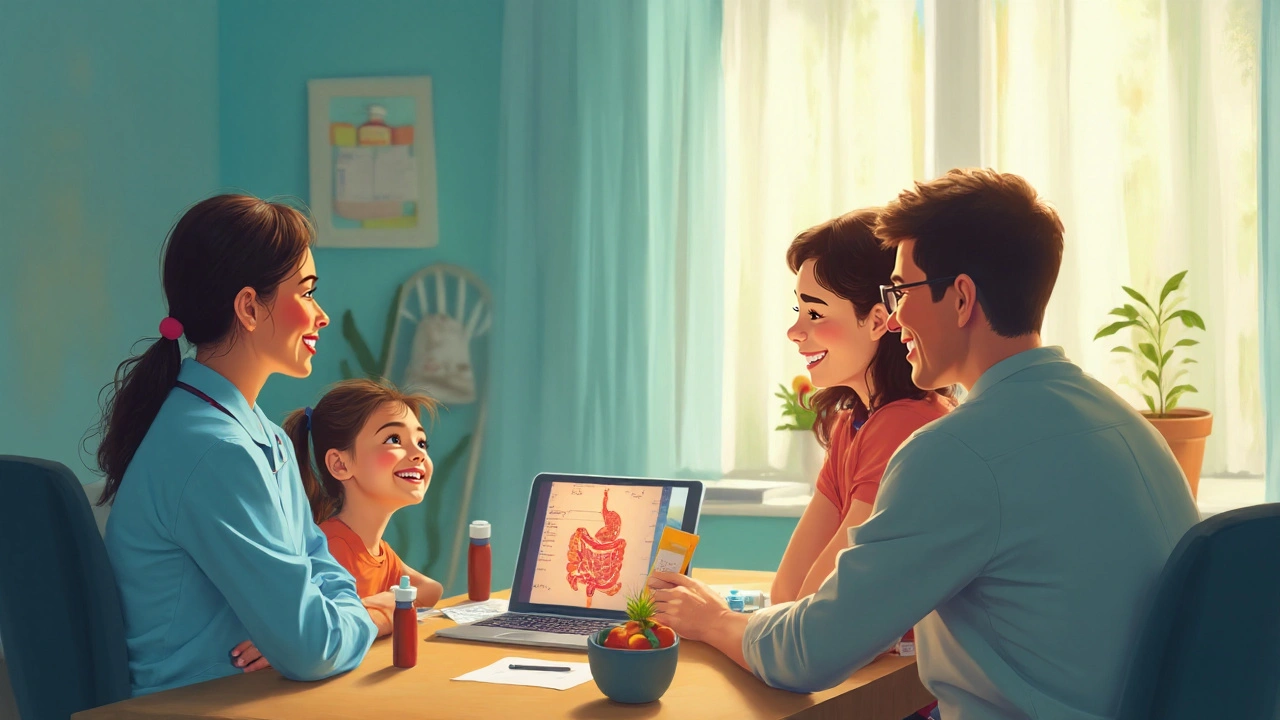Crohn's disease is a chronic inflammatory bowel disease that can affect any part of the gastrointestinal tract, but most often targets the end of the small intestine and the beginning of the colon. In children, the disease adds a layer of complexity because growth, nutrition, and school life are at stake. Early detection makes a huge difference in preventing long‑term complications.
Spotting the Red Flags
Kids rarely say, “I have an ulcer,” so parents have to watch for patterns. The most common signals include:
- Persistent abdominal pain, especially after meals.
- Diarrhea that may be bloody or contain mucus.
- Unexplained weight loss despite a normal or increased appetite.
- Fatigue that doesn’t improve with sleep.
- Delayed growth or a sudden drop in height percentile.
When any two of these appear together for more than a few weeks, it’s time to think beyond a simple stomach bug.
Key Diagnostic Tools
Diagnosing pediatric Crohn's requires a combination of labs, imaging, and endoscopic evaluation.
Fecal calprotectin is a stool test that measures intestinal inflammation. Values above 250 µg/g are highly suggestive of IBD and help decide whether a colonoscopy is warranted.
Colonoscopy with biopsies remains the gold standard. It visualizes ulcers, strictures, and allows pathologists to confirm granulomas, the hallmark of Crohn's.
When the disease is suspected in the small intestine, an Magnetic Resonance Enterography (MRE) offers a radiation‑free way to map the extent of inflammation and detect fistulas.
Blood work typically includes a complete blood count (to catch anemia), C‑reactive protein (CRP) for acute inflammation, and vitamin D and B12 levels because malabsorption is common.
Choosing a Treatment Path
Therapy aims to induce remission, maintain it, and support growth. The choice depends on disease severity, location, and how the child responds to initial meds.
| Medication Class | Mechanism | Onset of Action | Typical Pediatric Dose | Common Side Effects |
|---|---|---|---|---|
| Systemic Steroids | Broad anti‑inflammatory | Days to 2 weeks | Prednisone 0.5-2 mg/kg/day | Weight gain, mood swings, bone loss |
| Immunomodulators (e.g., azathioprine) | Suppresses immune cell proliferation | Weeks to months | 2-2.5 mg/kg/day | Liver enzyme elevation, nausea |
| Biologics (e.g., infliximab) | Targets tumor necrosis factor‑α | 2-6 weeks for induction | 5 mg/kg IV at weeks 0, 2, 6 then q8w | Infusion reactions, infection risk |
| Exclusive Enteral Nutrition (EEN) | Alters gut microbiome & reduces antigen exposure | 2-4 weeks | 100% of calories from formula for 6-8 weeks | Temptation to cheat, palate changes |
For mild disease, many pediatric gastroenterologists start with exclusive enteral nutrition because it avoids steroids and can promote mucosal healing. Moderate to severe cases often jump straight to biologics, especially if growth is stalling.

Living with Crohn's: Daily Strategies
Beyond meds, families need a plan for school, sports, and social life.
- Nutrition support means a dietitian‑guided menu that balances high‑protein foods, low‑residue meals during flare‑ups, and supplementation of iron, calcium, and vitamin D.
- Maintain a symptom diary. Recording meals, bathroom frequency, and pain scores helps the care team fine‑tune treatment.
- Plan for school accommodations: extra bathroom passes, a discreet medication locker, and a written emergency action plan.
- Encourage gentle exercise like swimming; it supports muscle mass without jarring the abdomen.
- Connect with peer groups. The Crohn's & Colitis Foundation runs youth camps and online forums that reduce isolation.
When to Call the Specialist
If any of the following occurs, seek pediatric gastroenterology care immediately:
- Sudden, severe abdominal pain that doesn't ease with rest.
- Persistent vomiting or inability to keep fluids down.
- Rapid weight loss (>5% of body weight within a month).
- Signs of anemia: pale skin, shortness of breath, extreme fatigue.
- Fever over 101°F (38.3°C) lasting more than 24 hours.
Early intervention can prevent complications like fistulas, strictures, or growth retardation.
Related Topics to Explore
Understanding Crohn's in children opens doors to broader conversations:
- Ulcerative colitis - the sister IBD that primarily affects the colon and has a different treatment algorithm.
- Pediatric gastroenterology - the medical specialty that handles all digestive disorders in kids, from celiac disease to liver disorders.
- Genetic testing for IBD - emerging panels that identify risk variants in NOD2, ATG16L1, and other genes.
- Long‑term monitoring tools such as the Pediatric Crohn’s Disease Activity Index (PCDAI) and regular bone density scans.
These sub‑topics are natural next steps for families who want a deeper dive.

Frequently Asked Questions
How early can Crohn's disease appear in children?
Symptoms can start as early as preschool age, but most diagnoses cluster between ages 10 and 15 when growth spurts make weight loss more noticeable.
Is exclusive enteral nutrition safer than steroids?
EEN avoids the bone loss, mood changes, and weight gain linked to steroids. It’s especially attractive for kids who need to keep growing, though adherence can be challenging.
Can Crohn's disease be cured?
Currently there is no cure. The goal is long‑term remission, which many children achieve with modern biologics and nutritional therapy.
What diet should my child follow during a flare?
A low‑residue, easy‑to‑digest diet works best: plain rice, boiled potatoes, lean proteins, and well‑cooked carrots. Avoid high‑fiber foods, nuts, and raw cruciferous vegetables until symptoms settle.
How often should my child see a gastroenterologist?
During active disease, visits are often every 4-6 weeks to adjust meds. Once in stable remission, follow‑up can stretch to every 3-6 months, with labs and growth checks each visit.
Are there any new therapies on the horizon?
Research is advancing with Janus kinase (JAK) inhibitors and stem‑cell‑derived microbiome transplants. Early trials show promise, but they’re still experimental for pediatric use.


jennifer sizemore
September 25, 2025 AT 05:35My niece was diagnosed last year at 12, and EEN changed everything. She hated the formula at first, but we made it fun with silly straws and themed flavors. She gained back 15 pounds in 8 weeks and went from barely walking to swimming laps. No steroids, no mood swings - just pure healing. If you’re scared of it, just try it for two weeks. You’ll be shocked.
Jillian Fisher
September 25, 2025 AT 18:41Does anyone know if the PCDAI is still used much these days? My kid’s doc mentioned it, but I couldn’t find it on the foundation’s site anymore.
Kimberly Ford
September 25, 2025 AT 20:39Yes, it’s still used - just less publicly promoted. Many clinics still track it internally because it’s one of the few tools that measures both symptoms and growth. It’s clunky, but it works. Ask your GI for a copy - they’ll usually print it out for you. Also, keep a symptom diary with timestamps. It makes appointments 10x more useful.
jerry woo
September 26, 2025 AT 13:41Oh god, here we go again with the ‘just eat bland food’ nonsense. You know what really helps? Cutting out the fucking industrialized food supply. Kids with Crohn’s are basically walking biohazard detectors for emulsifiers, maltodextrin, and glyphosate-laced corn syrup. The real cure isn’t in a pill - it’s in ditching the entire American diet. I’ve seen it. My cousin’s kid went from wheelchair to track team after going primal. No meds. Just meat, eggs, and rage.
matt tricarico
September 27, 2025 AT 06:14Interesting. Your cousin’s anecdote is charming, but it lacks statistical power. The only thing proven to induce mucosal healing in pediatric Crohn’s is biologics, specifically anti-TNF agents, with remission rates of 60-70% at 52 weeks in RCTs. Your ‘primal’ diet is a placebo with extra steps and a higher risk of malnutrition. Also, glyphosate isn’t even classified as a human carcinogen by IARC. Please stop.
Patrick Ezebube
September 27, 2025 AT 16:20Of course they don’t want you to know the truth. Big Pharma and the FDA are in bed with the food giants. MRE scans? They’re just surveillance tools to track your child’s gut flora for the next phase of the vaccine microchip rollout. They’re using the ‘Crohn’s’ label to normalize chronic immunosuppression so kids become easier to control. Look at the timing - it spiked right after the 2015 GMO labeling laws were blocked. Coincidence? I think not.
Armando Rodriguez
September 28, 2025 AT 03:02It’s exhausting seeing how quickly this thread devolved into conspiracy theories and pseudo-science. For the parents reading this - please, don’t let fear override evidence. Crohn’s is brutal, but we have tools now that work. EEN, biologics, dietitians, school plans - they’re not perfect, but they’re real. My daughter’s in remission at 14. She plays soccer. She’s in honors. She doesn’t need a ‘primal diet’ or a ‘microchip-free gut.’ She needs a team that listens. And you can build that team. Start with your pediatric GI. Don’t scroll past the facts because they’re boring. They’re your lifeline.